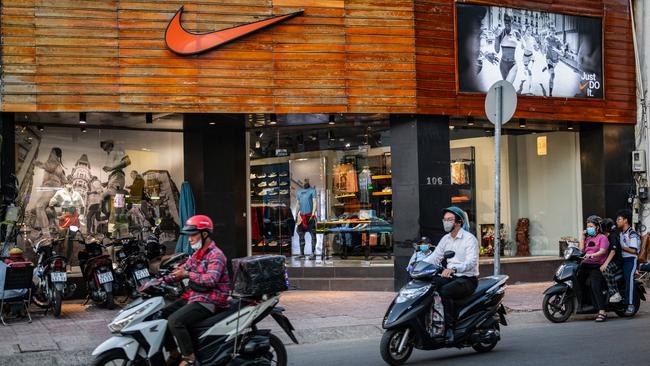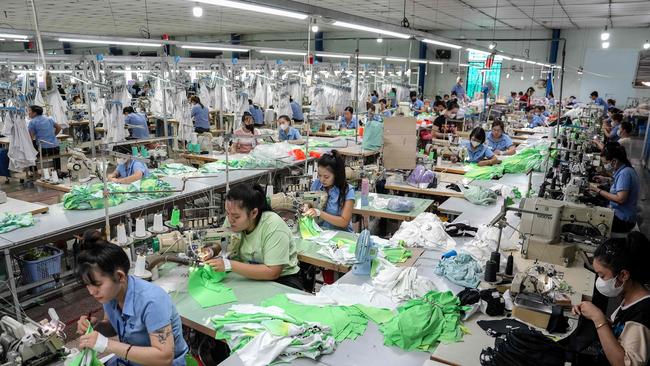US tariffs push Southeast Asia into China’s arms
One likely reason for Donald Trump coming down so hard on Southeast Asian nations is they are seen to have aided and abetted Chinese efforts to circumvent US trade sanctions.

Southeast Asian nations are scrambling to mitigate the potentially devastating impact of the Trump administration’s tariff punishment amid expectations of mass job losses and warnings the move cedes victory to Beijing in the US-China competition for regional influence.
The governments of Vietnam, Thailand and Cambodia – three export nations deeply reliant on the US market – all called for calm as they worked on responses to Thursday’s shock imposition of 46 per cent, 36 per cent and 49 per cent tariffs respectively in the hope of negotiating them down in coming weeks.
But Cambodia’s commerce ministry said on Friday the tariffs were “not reasonable”, pointing out US imports into the impoverished country were taxed at an average rate of 29.4 per cent, and that US consumers would suffer from higher-priced clothing produced in its garment factories.
Singapore announced a possible downgrade of full-year growth forecasts on the back of Thursday’s worse than expected tariff announcements, while Malaysia said it would focus on multilateral trade deals such as the Comprehensive Progressive Trans-Pacific Partnership Agreement (which the US opted out of), and diversifying its export markets.
None of the 10 Association of Southeast Asian Nations states has threatened reciprocal trade measures. But the Indonesian government’s initial reaction was telling.
While Jakarta has promised to simplify regulations such as Halal Islamic compliance rules that could be deemed non-tariff barriers, a presidential spokesman also suggested the White House-instigated turmoil vindicated Prabowo Subianto’s haste in joining the China-led BRICS group of developing nations within days of his inauguration.
“This step strengthens Indonesia’s position in international trade,” he said, as did Indonesia’s membership of the Regional Comprehensive Economic Partnership Agreement which included all ten ASEAN nations plus Australia, China, Japan, New Zealand and South Korea.
Regional experts are now warning the US risks ceding broader regional influence by pushing ASEAN and China closer together on trade.
“It hands a pretty significant victory to China for the obvious reason that the US is effectively cutting ties with these countries,” said Lowy Institute International Economics Program director Roland Rajah, adding the US withdrawal also undermined Australia’s efforts to help Mekong states diversify their trade relationships away from China.
“Most countries in the region are export driven and you’re taking the biggest market off the table,” he said.
“No one wants to call them out straight away because everyone is hoping to make a deal but eventually you can imagine a massive backlash as a result of economic dislocations and the social and political problems that brings.”

Even if the US eventually did lower its tariffs, the immediate effect would be to stall further investment causing a “tonne of damage”.
Baseline 10 per cent tariffs on all US imports will take effect on Saturday, and higher reciprocal tariffs on individual countries from next Tuesday, giving no time for businesses to adjust their supply chains.
Evan Feigenbaum, an Asia expert and vice-president of the Carnegie Endowment for International Peace, said on X the tariff announcements meant “the US is pretty much done in Southeast Asia”.
“The region is filled with pragmatists who can and do navigate all kinds of crazy stuff from outside powers,” he said.
One likely reason for Mr Trump coming down so hard on Southeast Asian nations is they are seen to have aided and abetted Chinese efforts to circumvent US trade sanctions.
At a recent press briefing, a White House official claimed Beijing had “turned Cambodia into the most important transhipment hub that Communist China uses to evade our tariffs”.
Vietnam has been the main beneficiary of the China-Plus-One strategy, but Thailand, Malaysia and Cambodia have also benefited from companies shifting some manufacturing and sourcing operations out of China in order to avoid US trade sanctions on Beijing.
Chinese manufacturers were not the only ones to do so, however, with plenty of US, EU and Japanese firms also setting up shop in Southeast Asia.
“Rather than primarily serving as a backdoor for Chinese exports, Vietnam should instead be seen as playing an important and helpful role in diversifying global supply chains away from China,” a Lowy Institute report said last month.
In the wake of Chinese AI firm DeepSeek’s apparent technology leap, Washington is also concerned Nvidia processors were being routed through some Southeast Asian countries before being shipped to China, potentially violating US sanctions on China’s access to high-end chips for artificial intelligence development.
Amid all the gloom, some sectors see potential advantage in the fact that China has been hardest-hit with US tariffs of some 54 per cent.
Malaysian glove manufacturers rallied on the realisation locally made gloves would now be $US6 per 1000 pieces cheaper than Chinese equivalents, even after Malaysia’s 24 per cent tariffs were factored in.
India, too, is said to be examining whether the announcement “presents an opportunity” to drive up exports in its textiles, electronics and machinery sectors given it got off relatively lightly (26 per cent) compared to trade rivals China, Vietnam, Thailand and Bangladesh (37 per cent).
While Taiwan leads in semiconductors, even a partial supply chain shift from Taiwan, driven by 32 per cent tariffs, could work in India’s favour, Delhi-based think tank Global Trade Research Initiative said in a note.




To join the conversation, please log in. Don't have an account? Register
Join the conversation, you are commenting as Logout